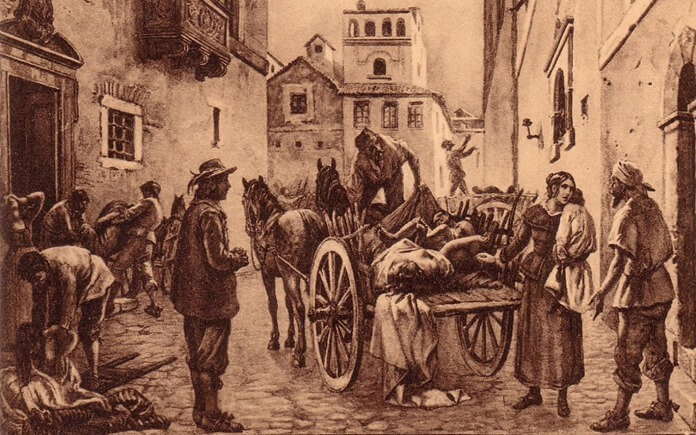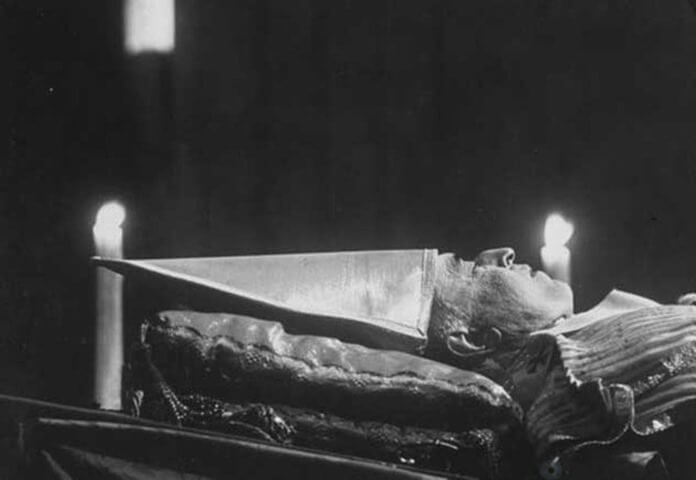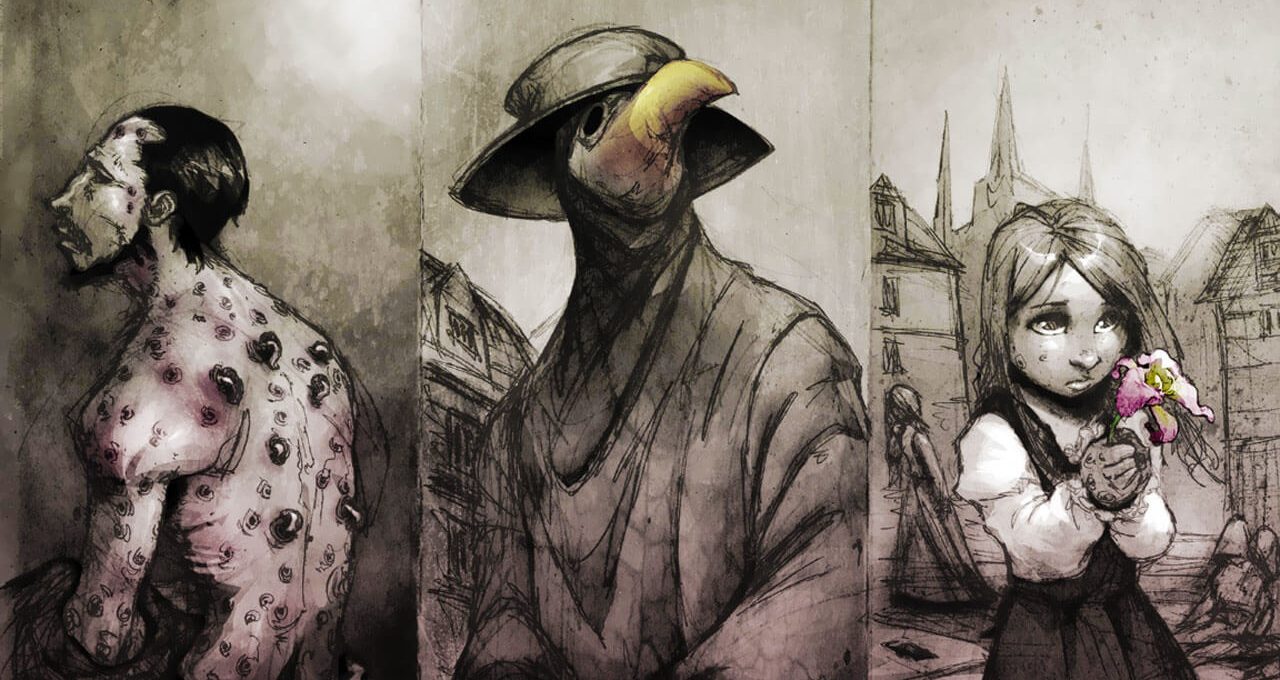The history of mankind is replete with shocking episodes and scary stories, compared to which any horror film seems like a children's horror story.
We present you the top 7 most terrible historical events that can serve (and sometimes do serve) as a source of inspiration for creating a game, film or book.
7. Zombie apocalypse in the UK
 Zombie movies are no longer a surprise. Countless armies of the living dead wandering aimlessly through the streets, panic among the few survivors... That's pretty much how things were in England during the Great Plague (1665-1666).
Zombie movies are no longer a surprise. Countless armies of the living dead wandering aimlessly through the streets, panic among the few survivors... That's pretty much how things were in England during the Great Plague (1665-1666).
London authorities tried to limit the spread of the disease by quarantining the homes of those who fell ill. All family members of a person who died of the plague had to stay in their home for 40 days without leaving, and a guard was stationed at the door to ensure that the quarantine was not violated.
Given that most homes had minimal food and medicine, it is easy to imagine the desperation and fear of the quarantined people and their desire to escape. Killing guards was common practice, and one deranged victim of the disease went so far as to make homemade explosives.
6. Attack of the Dead
An episode of the defense of the Osowiec fortress during the First World War went down in history under this journalistic title.
The Germans besieging the fortress used a large amount of liquid chlorine against its defenders from the 13th company of the 226th Zemlyansky regiment. And they supplemented the chemical attack with artillery fire, creating a real hell for the Russians, from which no one was supposed to leave alive.
"We had no gas masks, so the gases caused terrible injuries and chemical burns. When we breathed, we wheezed and bloody foam came out of our lungs. The skin on our hands and faces bubbled. The rags we wrapped around our faces did not help. However, the Russian artillery began to act, sending shell after shell from a green chlorine cloud towards the Prussians. Then the head of the 2nd Osowiec Defense Department, Svechnikov, shaking from a terrible cough, wheezed: "My friends, we are not going to die like Prussian cockroaches from poisoning, let's show them so that they will remember forever!" — from the memoirs of a participant in the events, the commander of a half-company of the 13th company, Alexei Lepeshkin.
This attack so frightened the Germans that they rushed to flee from the bloody, mutilated people, and many died from the fire of the fortress artillery, hanging on their own barbed wire.
These events formed the basis of the short film Attack of the Dead: Osowiec, released in 2018.
5. Waterloo soldiers were used for fertilizer and dentures
 By the early 19th century, the idea had spread in England that calcium-rich bones were a valuable fertilizer. And for several years after Napoleon's defeat, agents for fertilizer manufacturers combed the battlefields.
By the early 19th century, the idea had spread in England that calcium-rich bones were a valuable fertilizer. And for several years after Napoleon's defeat, agents for fertilizer manufacturers combed the battlefields.
The bones of men and horses were taken from places like Austerlitz, Leipzig and Waterloo and sent for processing, usually to Hull and Doncaster. It seems a shocking lack of respect for the dead, but these were different times. For centuries, corpses on battlefields had been looted by other soldiers and local farmers, and the Napoleonic wars were no different.
Long before the arrival of the bone dealers, many of the bodies in Waterloo were missing teeth. Dentures made from human teeth were known for many years as "Waterloo teeth."
The Battle of Waterloo also spawned tourism. Amazingly, there are reports of Britons walking to the battle site to witness the action in real time, like spectators at a sporting event.
4. Jack the Ripper was never caught
 The story of Jack the Ripper began on August 31, 1888, when the body of a woman was found dead in Whitechapel. Her throat had been slit and her stomach had been ripped open.
The story of Jack the Ripper began on August 31, 1888, when the body of a woman was found dead in Whitechapel. Her throat had been slit and her stomach had been ripped open.
Three months later, when what became known as the "Autumn of Terror" ended, the same terrible fate befell four more women.
Scotland Yard was baffled from the start of the investigation. The only thing known for sure about Jack the Ripper was that he killed women. According to Edmund Reid, one of the detectives assigned to investigate the murders, all of Jack's crimes were similar:
- All five women were active or former prostitutes;
- all the victims were from the lower class;
- everyone lived close to each other;
- and all the murders were committed after the pubs closed.
To Reed's key facts, there is one other significant detail: no one ever heard cries for help, which is highly unusual in a densely populated area like Whitechapel. None of the bodies showed any wounds consistent with self-defense, such as cuts or bruises to the hands and arms. And three of the victims were found with their internal organs removed, which Jack apparently took with him. He included a kidney from one of the victims in a letter "From Hell" that he sent to a member of the Whitechapel Vigilance Committee. The letter states that Jack the Ripper "roasted and ate" the other kidney.
One of the women told police that she saw the second victim, prostitute Annie Chapman, accompanied by a "foreigner" of medium height, wrapped in a dark raincoat. But whether this was Jack the Ripper or one of Annie's clients, we will never know.
3. Pope Pius XII's body exploded after his death
 Pope Pius XII did not want his internal organs removed by embalmers after his death. Everything had to remain in the same state “as God created it.” So Riccardo Galeazzi-Lisi, the pontiff’s physician, used a new embalming method developed by the Neapolitan professor Oreste Nazzi.
Pope Pius XII did not want his internal organs removed by embalmers after his death. Everything had to remain in the same state “as God created it.” So Riccardo Galeazzi-Lisi, the pontiff’s physician, used a new embalming method developed by the Neapolitan professor Oreste Nazzi.
Galeazzi-Lisi hoped that the embalmed body of Pius XII would be preserved forever in a natural state. But something went wrong, and under the influence of the Mediterranean heat, the corpse of the Pope began to decompose rapidly, literally exploding from the inside. And this happened during the funeral ceremony.
The stench was so strong that even the staunch Scots Guards, who stood guard around the pontiff's body, felt ill.
In the end, Pius XII's body and Galeazzi-Lisi's career were destroyed in one day. But the doctor gained the dubious distinction of being the only person ever expelled from the Vatican.
2. The Duplessis Orphans
 It is terrible when even one child is tortured. What can we say if the number goes into the thousands. But that is how it was in the now prosperous and democratic Canada, in the province of Quebec, during the government of Maurice Duplessis (1940-1950s).
It is terrible when even one child is tortured. What can we say if the number goes into the thousands. But that is how it was in the now prosperous and democratic Canada, in the province of Quebec, during the government of Maurice Duplessis (1940-1950s).
All local schools, shelters and hospitals were entrusted to the management of the church. And about 20 thousand (according to other sources - up to 300 thousand) abandoned children, orphans, allegedly mentally ill children, as well as children born out of wedlock, came under the control of nuns and medical personnel.
Many of them were subjected to sexual abuse, medical experiments, drugs, beatings and forced to work like adults.
The truth about what happened to the Duplessis orphans only began to emerge in the 1990s. However, the Roman Catholic Church refused to take responsibility for what happened.
1. Serial killer during the London Blitz
 From early September 1940 to May 1941, Britain was bombed by Nazi Germany. This period was known as the London Blitz or the Great Blitz. But it wasn’t just the bombs that posed a danger to the people of the English capital.
From early September 1940 to May 1941, Britain was bombed by Nazi Germany. This period was known as the London Blitz or the Great Blitz. But it wasn’t just the bombs that posed a danger to the people of the English capital.
Under cover of darkness, serial killer Gordon Frederick Cummins terrorized the city, killing seven women. Four of them died.
Cummins, nicknamed the "Invisible Ripper," mutilated the bodies of his victims like Jack the Ripper. But unlike the elusive 19th-century serial killer, Cummins was brought to justice.
This was facilitated by chance: when the killer pounced on his next victim, a night porter was nearby, who shone a torch in Cummins' face. The maniac fled, dropping his service respirator. The police found the owner using the serial number on this product. The evidence was enough to sentence London's "Invisible Ripper" to death.














Оставить Комментарий